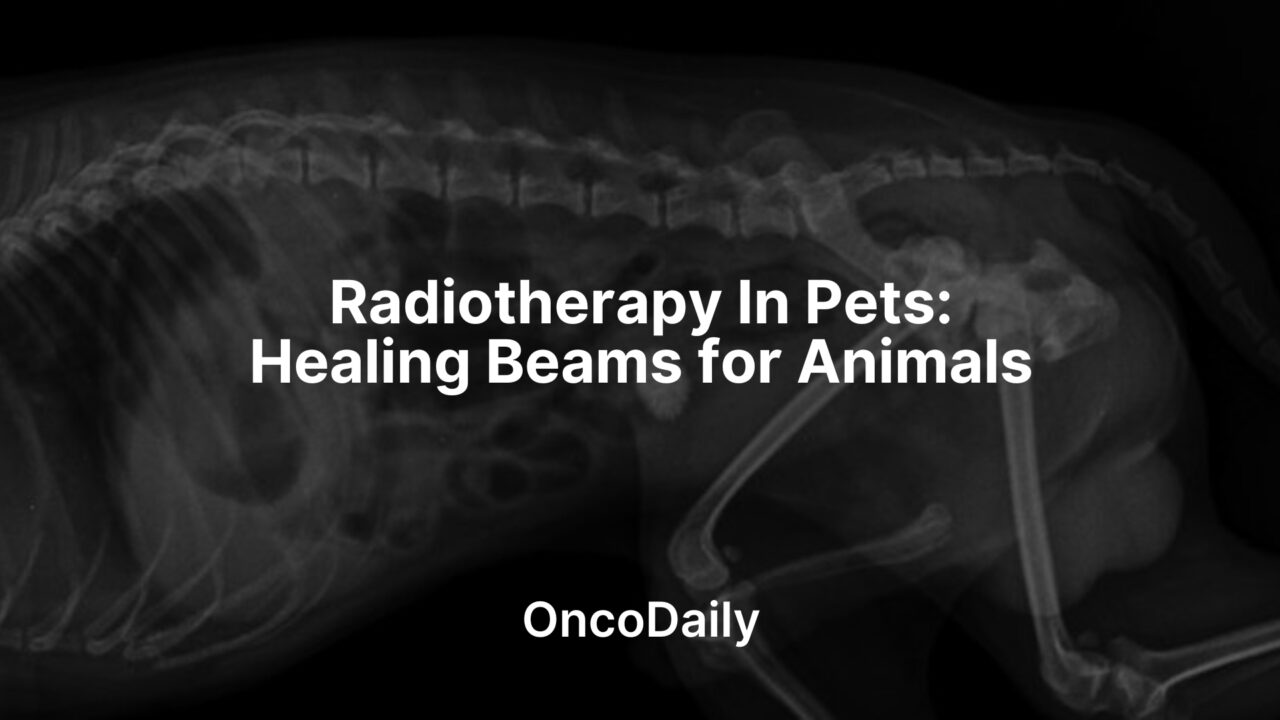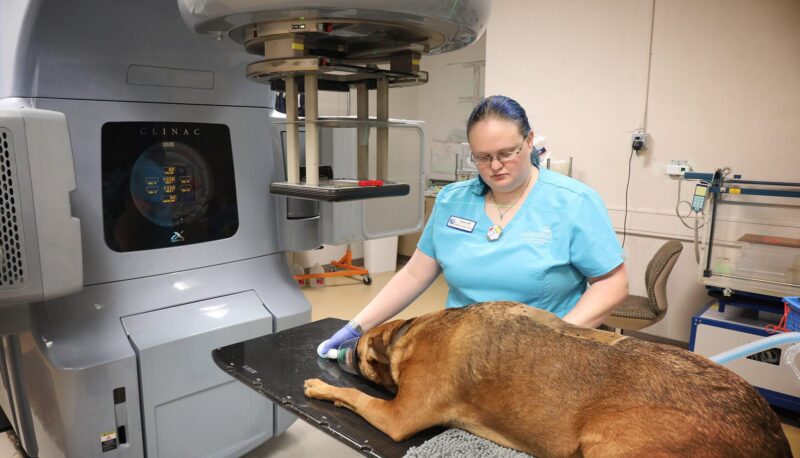
Radiotherapy In Pets: Healing Beams for Animals
Radiotherapy in pets (RT) is a crucial treatment veterinarians may recommend for dogs and cats battling cancer. It works by precisely targeting tumors with high-energy beams to damage cancer cells, aiming to either destroy them or slow their growth. This advanced care offers a vital path to help control tumor progression, reduce the risk of cancer recurrence, alleviate pain, and ultimately enhance or extend a pet’s quality of life.
What is Radiotherapy?
Radiation therapy, also known as radiotherapy or radiation, is a significant treatment option often recommended by veterinarians for pets, specifically dogs and cats, diagnosed with cancer. At its core, it involves directing high-energy particles or waves precisely at a tumor to target and damage the DNA within cancer cells. This process aims to kill these cancer cells directly or significantly impede their growth and replicating ability.
While it’s primarily used for identifiable tumors that haven’t spread, particularly when surgery is complex or not preferred, it’s not ideal for all cancer types, such as systemic lymphoma (though it can be used for localized lymphoma). The treatment goals can vary, from providing a potential cure with aggressive plans to offering palliative care, which focuses on improving the pet’s quality of life and relieving pain with lower doses and fewer treatments. It can be used as a standalone treatment or in combination with other modalities like surgery or chemotherapy. Recent technological advancements allow for more targeted radiation delivery, minimizing harm to surrounding healthy tissues.

source: www.bluepearlvet.com
Radiotherapy in Pets
Radiation therapy is an essential and often recommended treatment for various cancers in companion animals, particularly dogs and cats. Fundamentally, it involves precisely targeting cancerous cells and tumors with high-energy particles or waves. This radiation damages the DNA within cancer cells, killing them outright or significantly impeding their ability to grow and divide. The precise delivery aims to maximize harm to neoplastic tissue while minimizing exposure to surrounding healthy cells.
The goals of radiation therapy can vary significantly. Some treatments are administered with a curative intent, using higher, more aggressive doses to achieve long-term tumor control or complete eradication, often for localized tumors where surgery is not ideal or insufficient. Alternatively, for advanced cancers or to enhance quality of life, palliative treatments use lower doses to alleviate pain, discomfort, and other clinical signs associated with the tumor, focusing on comfort rather than a complete cure.
Conventionally Fractionated Radiation Therapy (CFRT)
CFRT represents a traditional and widely used standard of care in veterinary radiation therapy. This approach divides the total prescribed radiation dose into numerous smaller individual treatments, known as fractions. Typically, these fractions are administered daily, Monday through Friday, over an extended period, often spanning three to seven weeks, with 15 to 21 total sessions. The rationale behind this fractionation is to allow healthy tissues, which have a greater capacity for repair, to recover somewhat between doses.
This cumulative effect favors the destruction of cancer cells while minimizing long-term damage to normal tissues. CFRT can be delivered using various beams (X-rays or electrons) and may involve multiple beams of differing size, shape, and intensity. While generally effective for tumor control, especially for microscopic disease after surgery, CFRT can have a higher chance of acute side effects (around 50%), which usually occur in rapidly proliferating tissues like skin and mucous membranes.
Stereotactic Body Radiation Therapy (SBRT) / Stereotactic Radiotherapy (SRT)
SBRT, often referred to as Stereotactic Radiosurgery (SRS) or Stereotactic Radiotherapy (SRT), is a more recent and highly innovative advancement in veterinary oncology. This technique delivers significantly higher doses of radiation to the tumor in a much smaller number of treatments, typically just one to five fractions, often on consecutive or alternating days within a single week. The hallmark of SBRT is its submillimeter precision, achieved through sophisticated image-guidance (like Cone Beam CT, or CBCT) and rigid patient immobilization.
This extreme accuracy allows for the delivery of an “ablative” dose directly to the tumor while steeply and rapidly minimizing the dose to surrounding healthy tissues. This precise targeting significantly reduces the total number of anesthetic events required for the pet and generally leads to a lower chance of acute side effects (around 25%) compared to CFRT. While still maturing, data suggests SBRT can offer comparable or even superior survival times for many tumor types, particularly for grossly visible tumors. However, it requires highly specialized equipment and expertise to ensure its powerful dose delivery avoids severe adverse effects on normal tissues, especially for very large tumors or microscopic disease where targeting is less precise.

Read OncoDaily’s Special Article About Cancer In Dogs
How Radiotherapy Administered For Pets?
First, a CT scan of the tumor area is performed. This scan captures detailed “slice” images from multiple angles. These images are then used by a sophisticated computer program to create a 3D reconstruction of the tumor and its surrounding anatomy, including critical organs and tissues.
Next, a radiation oncologist develops a tailored treatment plan. This plan precisely instructs a linear accelerator – the “radiation machine” – where to direct the radiation beams and at what specific dosage levels. The aim is to optimize the delivery of radiation energy to the tumor while decreasing the dose to normal structures, which improves control rates and lessens the severity of complications. For complex tumors, this planning phase, often involving a dosimetrist, can require hours of work. MRI images, especially for CNS tumors, are frequently used alongside CT for tumor localization, though CT is still needed for dose calculation.
Crucially, throughout both the CT scan and all subsequent treatment sessions, pets are placed in immobilization devices. These devices ensure their exact starting position is highly reproducible, guaranteeing that the radiation consistently targets the correct areas. Because animals must remain perfectly still for this precise targeting, they are anesthetized for every treatment session. The anesthesia required is typically lighCt and the procedures are relatively short, making repeated anesthesia generally well-tolerated with proper monitoring.
The radiation is then delivered by a linear accelerator, which produces high-energy X-rays for deep-seated tumors or electron beams for superficial tumors. Contemporary techniques often incorporate image guidance via cone beam CT (CBCT), integrated directly into the treatment delivery system. This image-guided radiotherapy (IGRT) allows for real-time comparison with the original planning CT scan, enabling robotic adjustments to the treatment-positioning table to align the beam with the anatomy with submillimeter precision.
Radiation therapy is typically delivered in multiple doses over different days, a technique called conventionally fractionated definitive intent radiation therapy (CFRT), which allows healthy tissues to repair themselves between doses. These regimens can involve 10-20 individual doses (fractions). Alternatively, stereotactic radiotherapy (SRT) or stereotactic body radiation therapy (SBRT) delivers an intense, ablative dose in just 1-5 fractions, often on consecutive days, also requiring submillimeter accuracy.
Before each session, pets should fast for at least 10 hours, though water and prescribed medications are permitted. After treatment, pets usually wake up within minutes and are monitored closely before being returned to their owners
Side Effects of Radiotherapy For Pets
The side effects of radiation therapy in pets can generally be categorized into early (acute) effects and late (long-term) effects, with their occurrence and severity depending heavily on the specific area treated, the type of radiation protocol (CFRT vs. SRS/SRT), and the overall dose.
General & Early (Acute) Side Effects: Early side effects typically appear within a few weeks of starting treatment and can persist for about two to four weeks after the therapy is completed. These are usually inflammatory and occur in rapidly proliferating normal tissues. Pets receiving daily treatments (curative intent) may experience more discomfort, whereas those undergoing palliative radiation often experience little or no acute side effects.
Common generalized or superficial early side effects include:
- Skin irritation: This can manifest as a “sunburn” effect with pinkish-red skin, redness, irritation, or even moist or peeling skin (desquamation).
- Hair changes: Loss of fur in the treated area, and any regrowth may be a different color (dark fur growing back lighter, or light fur growing back darker) or white.
- Skin coloration changes: Hyperpigmentation, such as black patches of skin.
- Other skin symptoms: Dry skin, itchy patches, blistering, or ulceration.
- Fatigue
- Loss of appetite
Site-Specific Early Side Effects: Depending on where the tumor is located and the radiation field, specific symptoms may appear:
- Mouth: Excessive salivation, bad breath, formation of plaques or ulcers (mucositis), red mucus membranes, secondary infections, and reluctance to eat on the affected side of the mouth, or drooling.
- Eye: Inflammation of the eyelids (blepharitis), surface of the eye (conjunctivitis), and cornea (keratitis). The eye can become dry due to altered tear production, making it susceptible to corneal ulceration.
- Nose: As the tumor regresses, there might be nasal discharge or post-nasal drip.
- Ear: Your pet may experience otitis or signs similar to an ear infection.
- Toe: The toenail may grow oddly or even fall off (though it usually regrows), and the paw pad may become irritated.
- Gastrointestinal (GI) Tract: If the GI tract is within the field of radiation, your pet may experience diarrhea.
- Airway (Trachea/Esophagus): Tracheitis or esophagitis if these areas are in the field.
- Urinary Tract: Urethritis if the urethra is in the field.
These early side effects are generally temporary and often heal within 2-4 weeks after the course of treatment, with appropriate patient management, including pain medication, fluid therapy, feeding assistance, and e-collars.
Late (Long-Term) Side Effects: Late side effects typically occur months or even years after therapy. These are irreversible adverse effects that can manifest in slowly proliferating normal tissues such as bone, smooth muscle, brain, and the central nervous system (CNS). The probability and severity of these late effects are influenced by the total radiation dose administered and the dose per fraction.
Possible late or long-term side effects include:
- Tissue scarring: Brain, bone, and muscle tissue scars.
- Ocular issues: Dry eye, cataracts, or blindness.
- Loss of function
- Fibrosis or even necrosis of normal tissues (which dictates the design of radiation therapy plans).
It’s important to note that pets generally do not experience systemic radiation sickness symptoms like humans do (e.g., general lethargy, generalized diarrhea, or vomiting). With Stereotactic Radiotherapy (SRS/SRT), due to the precise targeting and minimal healthy tissue in the field, side effects tend to be much less common (around 25% chance) compared to Conventionally Fractionated Radiation Therapy (CFRT), which has a higher chance (around 50%). While palliative protocols generally have minimal early side effects, they carry a greater risk for late radiation effects if durable control unexpectedly occurs.
Costs of Radiotherapy for Pets
The cost of radiotherapy(costs in USA) ranges from $3,000 to $13,000, varying based on cancer type, tumor size and location, treatment intent (curative vs. palliative), and the chosen protocol (CFRT generally less than SRT). Pet insurance often covers a portion if acquired before diagnosis, and some facilities offer financing options.
Written By Aren Karapetyan, MD
FAQ
What is radiation therapy for pets?
Radiation therapy is a cancer treatment for animals like dogs and cats that uses high-energy beams to damage cancer cell DNA, aiming to kill or significantly slow tumor growth. It can be used alone, or with surgery and chemotherapy, for either curative or palliative purposes.
How is pet radiotherapy administered?
Pets undergo a CT scan to map the tumor in 3D, followed by a personalized treatment plan. For each short session, pets are anesthetized and placed in immobilization devices to ensure precise radiation delivery by a linear accelerator, minimizing harm to healthy tissues.
What are the main types of radiation therapy for animals?
The primary types are Conventionally Fractionated Radiation Therapy (CFRT), which delivers many small doses over several weeks, and Stereotactic Radiotherapy (SRT/SBRT), which delivers highly precise, larger doses in just 1-5 sessions. Other methods like brachytherapy and biologically targeted radiotherapy are also mentioned but are less common.
What are the common side effects of pet radiotherapy?
Side effects are usually localized to the treated area and can be early (acute) or late (long-term). Early effects often include skin irritation, fur loss, and site-specific issues like mouth ulcers or nasal discharge. Late effects are less common but can involve scarring or loss of function in tissues like bone or brain.
How much does radiation therapy for pets typically cost?
The cost of pet radiation therapy can range from $3,000 to $13,000, depending on factors such as the cancer type, tumor size, treatment intent (curative vs. palliative), and the specific protocol used. Pet insurance may cover a portion if acquired before diagnosis.
-
Challenging the Status Quo in Colorectal Cancer 2024
December 6-8, 2024
-
ESMO 2024 Congress
September 13-17, 2024
-
ASCO Annual Meeting
May 30 - June 4, 2024
-
Yvonne Award 2024
May 31, 2024
-
OncoThon 2024, Online
Feb. 15, 2024
-
Global Summit on War & Cancer 2023, Online
Dec. 14-16, 2023
